I’ve written pretty frequently about what before this pandemic were my annual trips to the Jura region, and my “Recent Wines” articles usually contain one or two Jura wines. I suppose that it might be the wine region most readers identify me with. Throughout the articles resulting from those visits I’ve usually thrown in a few ideas for things to do, but I thought now perhaps I have time to group my ideas together. I know a few people who are planning to head over to this beautiful part of Eastern France fairly soon, and although they are all wine obsessed, they don’t necessarily want to spend every moment in a cellar. Nor do their partners and children. So if you want to explore a region which has enough to offer even without the wine, read on.
Arbois
We always stay in Arbois. There are several reasons for this, but I must say I fell in love with the town pretty much the moment I’d driven up to the central Place de la Liberté for the first time and smelt the wood smoke. Arbois is not flashy, and that must be part of its charm, but nor is it a sleepy backwater (at least these days) with nothing to do but taste wine.
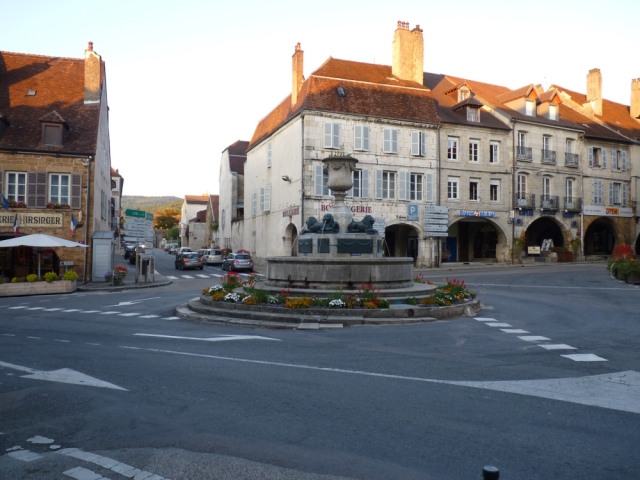
To begin, let us start with the shops. The town is almost unique in that a good number of the larger wine producers, and the Cave Cooperative, have wine shops in the town. Most of them are close to the central Place de La Liberté so you can wander between them at will, and taste there as well as buy. The coach parties will be heading to the largest of them all, that owned by mega-négoce Henri Maire. On the opposite corner of the Place is the shop of Domaine A&M Tissot, aka Stéphane and Bénédicte Tissot. Actually, this domaine (more of which later, when we go walking) doesn’t always encourage visits to its Montigny-les-Arsures base, though there is a tasting room there. But you can taste at the shop, and if they have any bottles left of the rarer cuvées, they are just as likely to be available here.
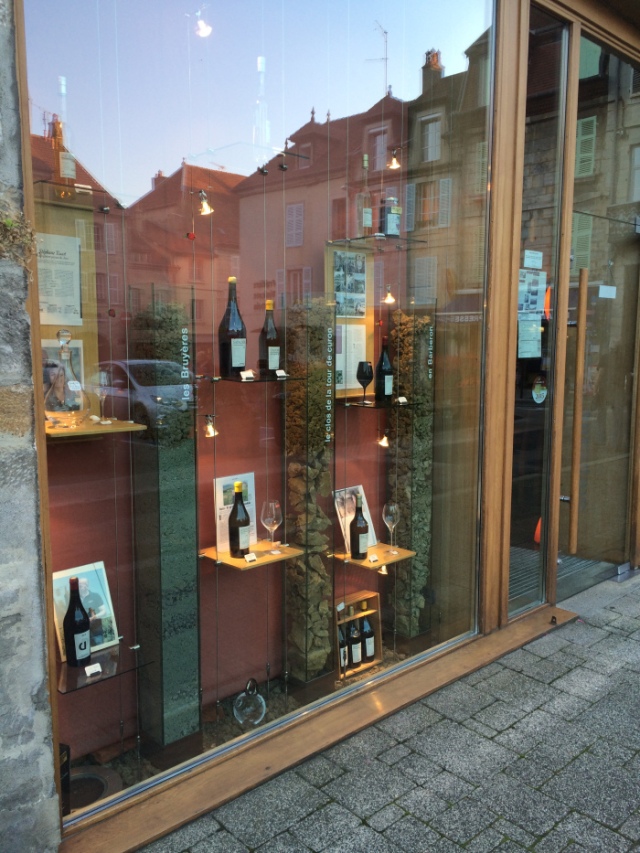
If you head southwest of the Place, towards the River Cuisance and the large Église St-Just, you will find the shop belonging to the town’s first biodynamic producer, Domaine de La Pinte (8 rue Hôtel de la Ville). Too often overlooked by the wine writers, this domaine’s shop can furnish some of their more interesting cuvées. Older Vin Jaune vintages (ask), skin contact wines and Melon à Queue Rouge (a famous red-stemmed Chardonnay mutation beloved of Jura geeks) are my first recommendations.
It’s also worth noting that the old family firm of Rolet, recently the subject of another Burgundian takeover in the region, and which has a shop almost opposite “Pinte”, has traditionally sold Vin Jaune in a “half-Clavelin”. This is as far as I know technically not allowed by the regulations but it sure makes Vin Jaune more affordable if current Clavelin prices are too steep. It is also a useful size if you really want to use it for cooking (a discussion for another time).
The best wine shop not owned by a single domaine in Arbois, for those of us who drink natural wines, is Les Jardins de Saint Vincent (49 Grande Rue, close to the Place but heading north, towards Dôle). It’s owned by Stéphane Planche, who as a sommelier and consultant has become perhaps the most trusted and experienced palate in Jura wine. This brilliant shop does, however, have occasionally unusual opening hours (for a time it was only open Friday and Saturday but appears now to have added 4.30pm to 9pm on Thursdays). They do tasting events as well.
There are three other shops I’d recommend for certain. For wine vinegar there is Vins et Vinaigres de Philippe Gonet at 16 Grande Rue (opposite side of the Place to Jardins and just past the arcades). I always start off any purchases with the Vinaigre de Vin Jaune and the Poulsard, but the choice is endless and the quality top notch.
Hirsinger is a chocolate and pastry shop which even the Parisians have heard of. Buy their chocolates, take away exquisite patisserie, or sit outside with a cake and a chocolat chaud, preferably all three. 38 Place de la Liberté, closed Wednesdays and Thursdays.
If you need cheese in Arbois, then Essencia en Arbois is a few doors along the same side of the road as Hirsinger. They also sell a few local wines, deli items, and Franche Comté beers (and usually have some of Eric Bordelet’s cider as well). We shall mention their main store when we visit Poligny.
For those who don’t mind straying along the Grande Rue in the other direction after a visit to Gonet, the Fruitière du Plateau Arboisien has its own shop up the hill at 1 rue des Fossés for excellent cheeses and some other produce. If you are staying and dining in, the butcher sited between the Henri Maire and Rolet shops has been very good in the past. Fresh meat, charcuterie and traiteurie and a daily takeaway “plat” are all available.
Before we leave Arbois, first on foot and then by car, I will mention some museums. There is a wine museum at the old castle of Château Pécauld (best access via the alley to the left of the vinegar shop and through the Porte Picardet). I think most people knowledgeable about Jura wines or who have already seen enough old wine equipment would find the following two museums more interesting, but I don’t regret my visit.
La Maison de Pasteur is really interesting and I would recommend a visit to this great scientist’s house (83 rue de Courcelles), even though opening hours seem currently to be confined to weekends (perhaps Covid-related). Pasteur’s house is a typical bourgeois dwelling and combines rooms featuring his science and typically furnished rooms of the period when he lived there.
Somewhat grander, though you’d not necessarily think so from its entrance off the Grande Rue, is the Musée d’Art – Hôtel Sarret de Grozon. Constructed between the 18th and early 19th centuries, this fascinating small aristocratic town house often has some interesting exhibitions alongside its period décor, furniture and art. Definitely worth a visit, occasionally open with free admission at certain times of year.
Dining
I’m not going to say too much here as Arbois has an increasingly varied selection of restaurants. You will certainly have read in my previous articles about the restaurant down towards the Pasteur house called La Balance. It became a firm favourite because of its possibilities (and warm welcome) for my wife, who is vegan. It changed hands a few years ago yet it seemed just as good, and welcoming, on our last visit in December 2018. I was told it had closed last year. It still appears to be open (or has reopened) according to Google. We shall certainly try to eat there next visit, but I suppose my previous glowing reviews, especially of their rustic take on poulet au vin jaune, should be read with this knowledge in mind.
Jean-Paul Jeunet has been renamed “Maison Jeunet” but still retains its two Michelin stars. It’s a classic old school French restaurant with famous dishes like stuffed hare, lake fish, and of course poulet au vin jaune. The wine list is far more modern, at least in part, than you might imagine and it’s also one of the few places you will be able to get good Vin Jaune by the glass. Expect very attentive service and a big bill. Jeunet has rooms, in which we have never stayed.
Right at the other end of the spectrum you have Les Claquets (Place Faramand) and the Bistrot de la Tournelle (Petit Place, on the river, summer only and closed if wet). Both serve simple plats to go with natural wine (including at the latter the stunning wines of the Domaine de la Tournelle, whose tasting room is at the same location).
If you desire a smart alternative to Jeunet, then Les Caudalies (also a hotel) may be an option. Nadine and Claude Troussard run a good kitchen, and sommelier Philippe Troussard was awarded the prestigious Meilleur Ouvrier de France title in 2015, backed by his 1,000-bottle cellar. The cheese board is often spectacular. It’s a little bit further out than the Pasteur house, on the opposite side of the road.
There are plenty of other places to try. You may wonder why I’ve not mentioned the prominent Aux Docks on the south side of the Place? We’ve never dined there after a rather brusque dismissal of my wife’s desire to eat dinner without meat or dairy in it. We have eaten a very nice meal with local friends at the Castel Damandre out at Les Planches-près-Arbois, a short drive, perhaps fifteen minutes or so, from the centre of town.
Walking
Arbois has lots of lovely walks, many of which begin in the town. The first thing you should do is to head to the Tourist Office, opposite L’Église St-Just, to get a free Arbois town map and to buy the Randonnée map “Arbois- Vignes et Villages, Pays de Louis Pasteur” (the scale is 1/25,000 and it cost me just 5€ back in 2015. The following walks are our favourites.
- Arbois circuit – Start on the Rue de L’Hôtel de Ville turning left after Maison Jeunet onto Petit Place. From here follow the Rue de Bourgogne past the Cave de la Reine Jeanne and turn right down the Rue de la Tour. Cross the tiny medieval bridge by the tower (almost crumbling, but it houses a gallery which is open to visit) and looking right you will see the Bistrot de la Tournelle by the waterside. Then take a look at the old vigneron houses on Place Faramand (and check out Les Claquets, maybe grab une verre). Heading back to the large Église St-Just, take the small road down to its left (towards the cemetery) and then the path on the right, by the plant nursery (which is signed). This takes you down to the river and affords some of Arbois’s nicest views. You walk along the river a little way with vineyards to the left and very possibly some small trout to your right, eventually coming out by the Pasteur house. The “promenade” route encapsulates a full circuit of the town, but this short stretch is the best bit.
- Montigny-lès-Arsures – this is marked on the Randonnée map and runs through the vines in large part (below the Les Corvées vineyard and the famous Tour de Curon). A pleasant walk with the added bonus that Montigny houses a large number of winemakers. Stéphane Tissot can be found a short walk down the hill to the left of the church, where if you don’t see him you will certainly see his amphoras lined up. For a longer walk return along the usually quiet road via Vauxelle. Look at the map. Can you see how a track in Vauxelle will link to the D107? From here look for the track before you reach La Colombière which will take you down to Mesnay (and then back to Arbois). These two tracks are marked as black lines on the IGN map mentioned at the end of this article so you could take both maps for security. The walk down to Mesnay is very attractive.
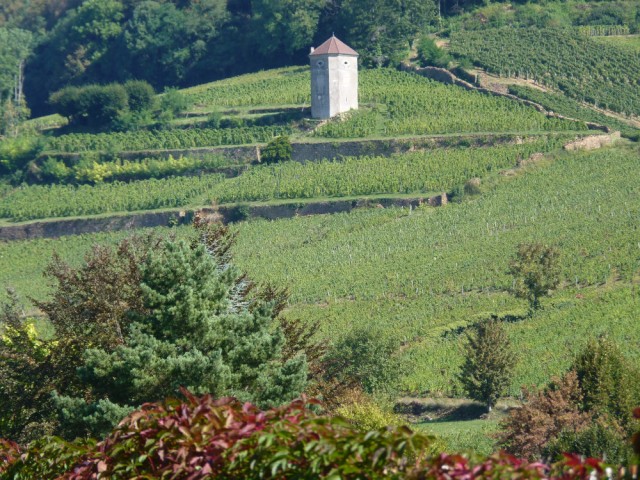
Tour de Curon and Stéphane Tissot’s terraced “Le Clos” vineyard seen from the walk to Montigny-les-Arsures
- The Hermitage and Beyond – 1. Pupillin: If you walk from Place Faramand out of town you soon pass the right hand turn to Pupillin. A little beyond this turn, on the right hand side of the D469, is a small roadside shrine and some steps leading to a path. Climb this path and you will reach the Hermitage chapel you can see high above the town. Climb the narrow road (more a paved track) to its left and the park above Hermitage has a great viewing platform for a photo of Arbois.
Clockwise: Hermitage from Place Faramand, path up to the chapel, view over Arbois from platform above the chapel
From here there are two great, if longer, walks. Where this road turns sharply left there’s a path in front of you, the GR59B, leading to the GR59. Follow it up and into the trees and you can eventually reach the wine village of Pupillin via the junction of pathways at Croix Bagier (see the randonnée map). Pupillin has a great restaurant, Le Grapiot, but you almost always need to book. As well as the famous wine names here (you won’t miss Pierre Overnoy’s house) there are also some good vineyard walks and a picnic site, over to your right, in the opposite direction to Arbois, out of the village. The quickest way to walk home from Pupillin is to avoid the main road and head down the walking path on your right a hundred metres or so after you leave the village. The road itself has a big bend on a hill, not great for pedestrians. This old cart track by a tiny brook is far more attractive, and it cuts off the corner.
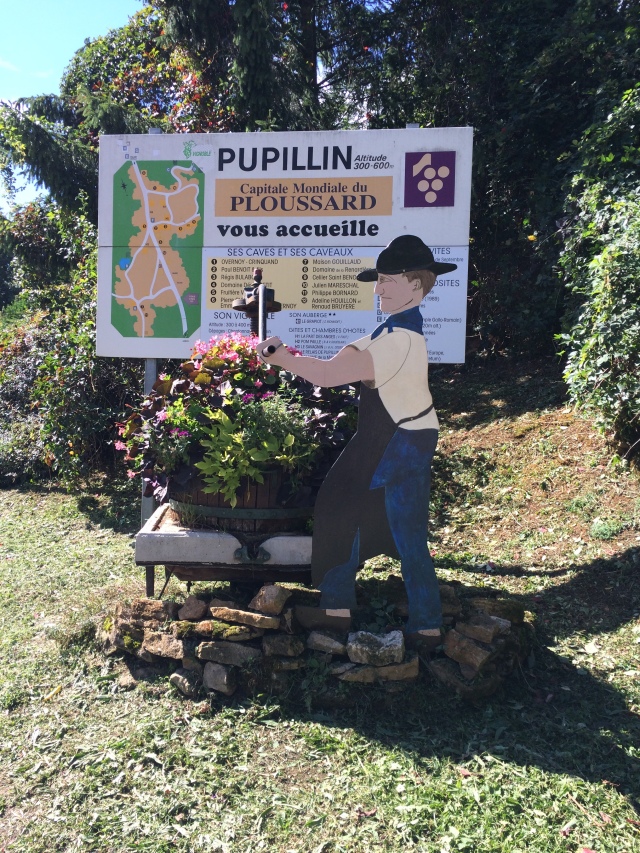
- The Hermitage and Beyond – 2. Les Planches: Instead of taking the GR59 path to Pupillin stay on the small road (also the GR59 but in the opposite direction) and you will pass through the “Allée du Roi de Rome”, an avenue of tall trees with its immensely tall Sapin du Président. From here a long ridge walk (of a little over 4km from the Hermitage) will eventually (if you take the correct path) come down into Les Planches. It is a walk which could be tricky in wet weather or with younger children, and the walk back to Arbois is quite long and by road (via Mesnay, look out for Patrice Beguet’s place next to the church), but I really like the walk for the forest up here. Les Planches is, of course, where you can walk a little further to see the Cascade des Tufs, not to be missed if you walk there, or drive to the Castel Damande restaurant.
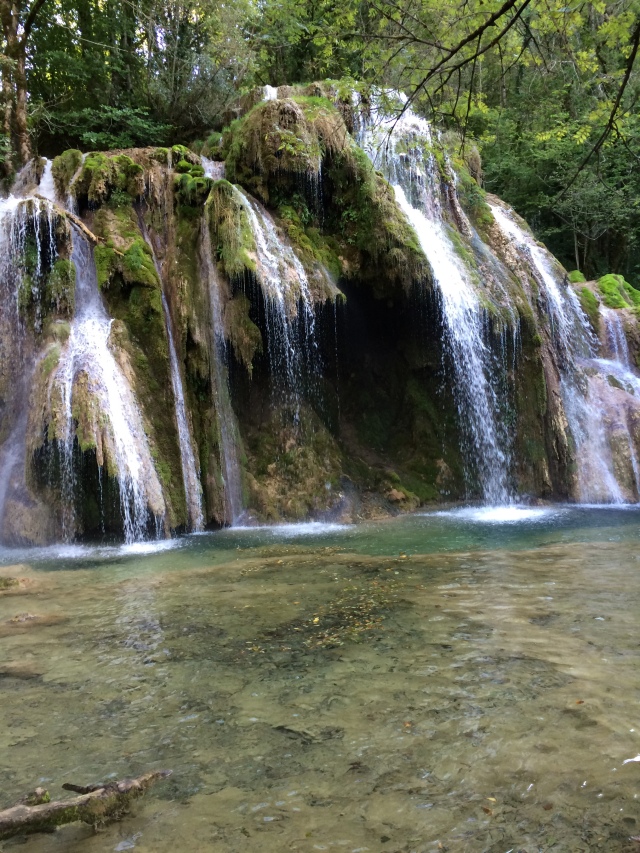
Part of the Cascade des Tufs
- La Châtelaine – This is a village on top of the rocks of the vast limestone Cirque of the Fer à Cheval. You need to drive here and we usually go up from Mesnay following the small roads through the fields (there’s a right turn off the D107 after Champ Paillard which switches back and is easy to miss…if you cross the railway you’ve gone too far, but the IGN map mentioned later and the Randonnée map both show it) . In the dense woodland accessed via the left of the church there are the ruins of a very old castle begun in the 12th century. The site is not without potential danger if you go close to the edge, but it’s a magical place, made more so because on pretty much every visit we have come across the herd of mouflons which inhabit the rocks. You can also (and should) walk along the path from the village itself which hugs the cirque here, towards Le Fer à Cheval, with many spectacular views over the end of this glacial valley. There’s a very basic but welcome bar here at the far end of the walk (marked by a coffee cup on the Randonnée map, close to the belvedere view point).
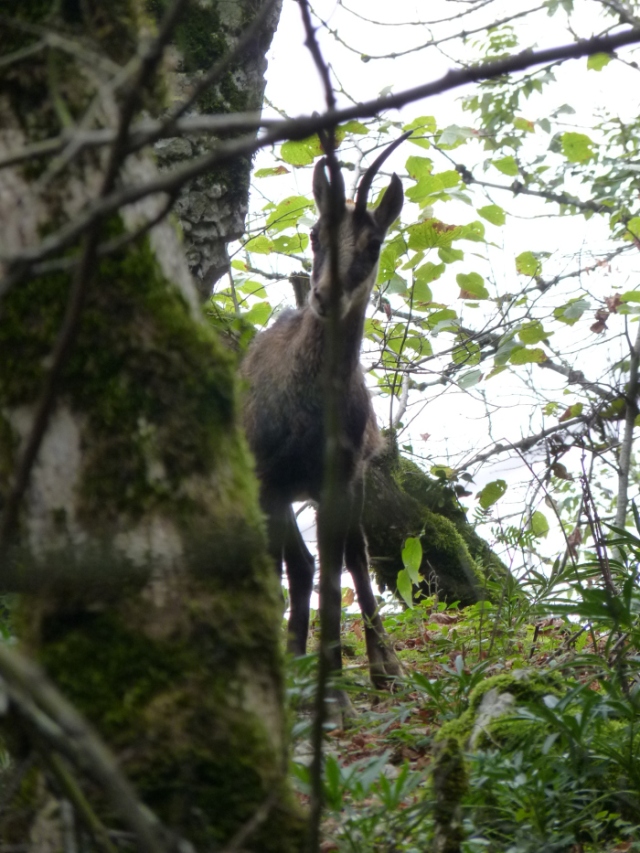
Jeune Mouflon at La Châtelaine
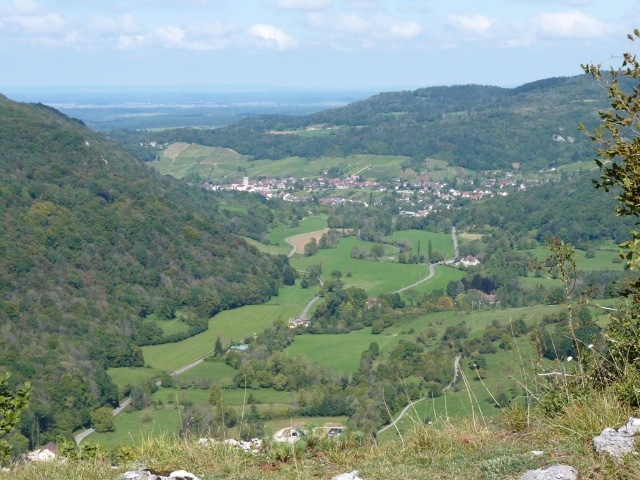
From the Fer à Cheval
Taking the Car
There are just so many places to visit from Arbois that I will doubtless be accused of missing your favourite. If I restrict this part of the article in some ways to the more obvious, then over time perhaps you will enjoy discovering some of the smaller and more off the beaten track places for yourself. Whilst there are plenty of places to visit to the north of Arbois, such as Salins-les-Bains overlooked by its twin forts, one of which, the Fort St-Antoine, is used by Marcel Petite to age thousands of rounds of Comté, or maybe the UNESCO Heritage Saline Royale at Arc-et-Senans, the town of Dole or picturesque Ornans on the River Loue, I think most tourists will head south.
It’s not far south to Poligny, though the route via Pupillin is more scenic than the swifter N83. I won’t lie, my main reason for visiting Poligny is for the original Epicurea (5 Place des Déportés right in the centre of town, aka Fromagerie Vagne which is on the sign above the door). The cheese shop has, as we have already noted, its brother in Arbois, but the wine selection here, taking up around 80% of the shop, is exceptional. Trust me.
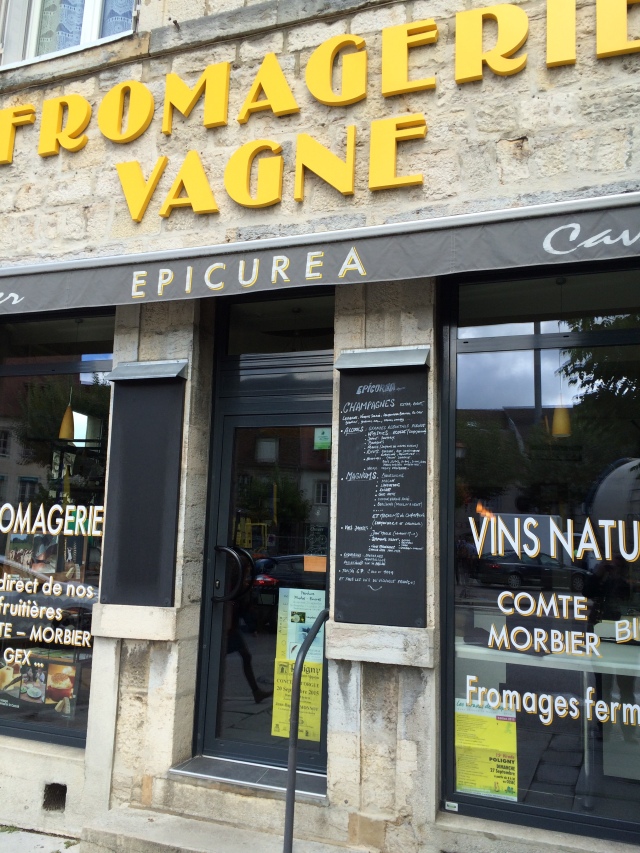
Poligny has its own very worthwhile town circuit (map from the tourist office on the opposite side of the Place des Déportés, number 20), and it is also worth going up to the heights of the Culée de Vaux, which towers over the town. So you may need somewhere for lunch in between. Not plush nor flash, but we were recommended La Muse Bouche (60 Grande Rue) for our last visit and can happily pass that on. A simple but tasty meal, and they have one of my favourite small Arbois producers on the list, Domaine de la Touraize.
Poligny also has one of the best book shops in the region, La Fruitière des Livres (3 rue Travot, just turn right off the Place on the Geneva Road). Usually has a decent wine section, including the wine bandes dessinées some of us enjoy.
Close to Arbois on the D469 towards Champagnole, and just after the Fer à Cheval are the caves called the Grotte des Moidons. I’m pretty sure you are aware we are in limestone scenery here, and Moidons is a classic large cave system with typical stalactite and stalagmite formations. Well worth a visit if you are not claustrophobic.
Most visitors with an interest in wine will wish to visit Château-Chalon, about as far further on from Poligny as Arbois. It really is a very attractive ensemble of buildings on a rock, whether seen from the vantage point on the edge of the village or from below, looking up through the steep vineyard to the limestone cliff on which the village sits. There’s a reasonably interesting museum to the right of the church (especially if it’s raining). To the left side of the church, about half way down a steep and narrow path, you will reach a small walled vineyard enclosed by an ironwork gate with vine tendrils. This is a nursery/conservatory of rare Jura grape vines. If you want to see the grape varieties Ganevat uses for some of his more obscure négoce bottles, take a look.
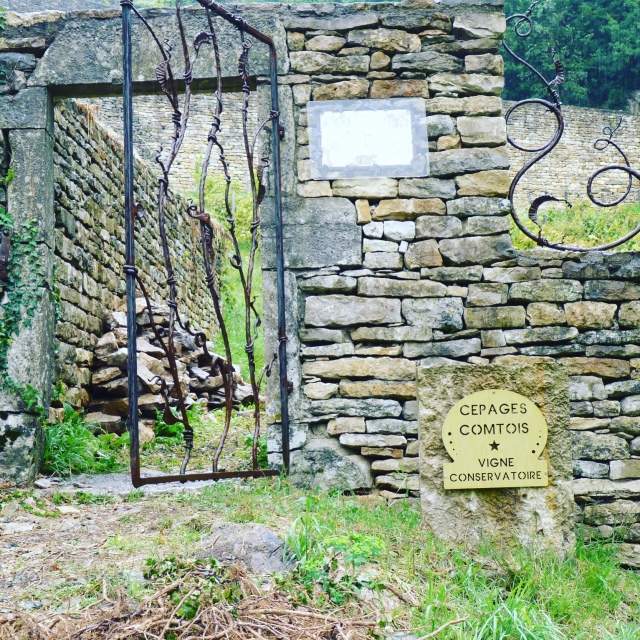
If you come to Château-Chalon do consider driving a little further for a look at the large Romanesque Abbey of Baume-les-Messieurs, which sits in the valley which leads to the spectacular limestone formation of the Cirque de Baume. Unless early religious architecture really just isn’t your thing.
The Jura region is effectively, to over simplify, three levels of terroir. The vines grow on slopes which lead up to plateau land, rich green pastures which feed the cows that make Comté. Above the plateau we get the mountains. Between the two sit several attractive lakes. The Lac de Chalain southwest of Champagnole, and the longer Lac de Saint-Point near Pontarlier, are both worth considering if you have small children. At either, but perhaps more easily at Chalain, you could spend an afternoon with a bucket and spade. En-route to St-Point, just outside Pontarlier, you will pass the imposing castle, remodelled by Vauban in the late 17th century, the Château de Joux. It once guarded the passes to Switzerland.
Another worthwhile trip with children is to drive even further south, past the largest of the region’s lakes (Lac de Vouglans) to visit the Musée du Jouet (toy museum) at Moirans-en-Montagne. It’s full of toys old and new. Check out the many photos on their web site to see whether the kids fancy it. And hey, you can always sneak back, with a detour east from Orgelet, via Rotalier and Grusse (if you see what I’m thinking).
I’ll finish with a couple of ideas for even longer day trips if you are spending a couple of weeks in the Jura. First, you can travel into Switzerland via Pontarlier, to seek out the wines of the Three Lakes Region, specifically the Lac de Neuchâtel, famous for its pale pink Oeil de Perdrix wines and the increasingly interesting unfiltered Chasselas Primeur made down here. Remember, don’t stray onto the Swiss autoroute without a motorway carnet.
My other idea is to head from Champagnole to one of the ski resorts in the High Jura, either near Les Rousses or perhaps the Col de la Faucille. The skiing here is mostly good ski de fond (cross-country) but there is some limited downhill around for an afternoon’s entertainment. This is the back route to Geneva, and the roads can be slow in winter, when the snow leaves barely enough room for one car. But if you are a winter sports enthusiast it’s worth it. There’s also good value skiing at Buttes-La Robella, towards the Lac de Neuchâtel. If you really fancy it a day trip to Geneva is certainly possible from your Arbois base, and you would drive via the Col de la Faucille. But the Col can be closed in heavy winter snow, so perhaps leave that trip for summer and the long evening light.
That should provide plenty to do if you decide to spend a week or two based in or near Arbois. That’s even without the dozens of producer visits you could make, some very welcoming and easy to get in at and some remarkably difficult. If you can sit in Pierre Overnoy’s kitchen eating his freshly baked bread you have better connections than I do. Remember, Arbois has many shops and restaurants I haven’t mentioned, and there are so many more excursions, to small rural museums or tiny castle ruins on hilltops. There’s even a Dinosaur Park (Dino Zoo) at Charbonnières-les-Sapins, close to Ornans, which may amuse small children.
What I want to convey is that there are so many possibilities in the region that anyone with a passion for Jura wine can easily satiate that whilst giving the rest of the family a holiday they will enjoy. In fact when we had children coincided with our switch from Burgundy (Beaune is also only an hour from Arbois) to Jura for our annual trip to rural France and it proved to be a good move.
If I don’t pass on one warning I might regret it…opening hours. Some of the shops and attractions have pretty strange opening times (remember Hirsinger, and Jardins de St-Vincent?), many opening on limited numbers of days, only in summer, etc. I would recommend checking anywhere and everywhere before making a visit. I would also recommend booking any restaurant in advance. Nowadays the region has been discovered, though to be fair when places are open in winter they may be very quiet.
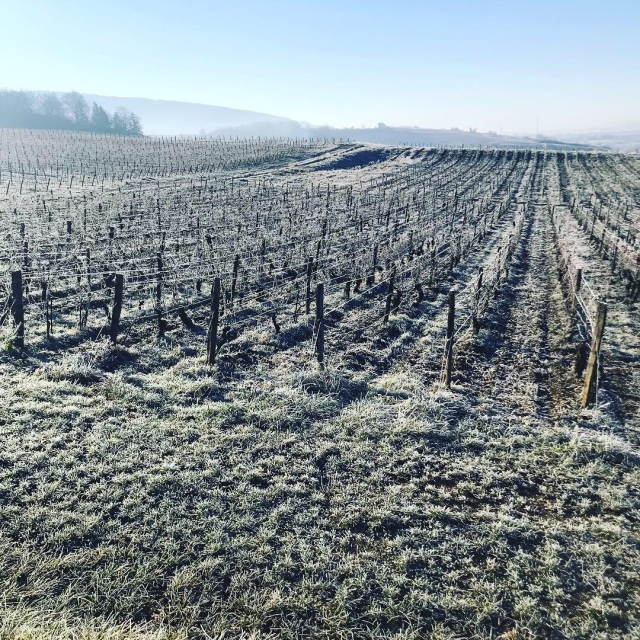
In addition to the Randonnée map I recommended you purchase from the Tourist Office if you like walking, there are three other useful things to have to hand, aside from a Michelin Road Atlas of France.
- IGN Série Bleu 33250 “Salins-Les-Bains-Arbois” is the “local” map at 1cm = 250m, so a decent scale. Available locally in almost any Tabac or book store.
- Arbois aux Vignobles Lumeux – this is a glossy booklet (in French), usually available in the book shop at the wine museum but probably elsewhere (10€, soft cover, 62pp). If you have a little French it’s a nice general guide to the town and its region, packed with colour photos.
- You will need Wink Lorch’s Jura Wine which covers far more than merely the wine producers (Wine Travel Media 2014, £25). This is most easily purchased direct from Wink Lorch via her winetravelmedia.com web site, with free UK postage. If you neglect to purchase this before you go you may find it in one of the bookshops in Arbois or Poligny.
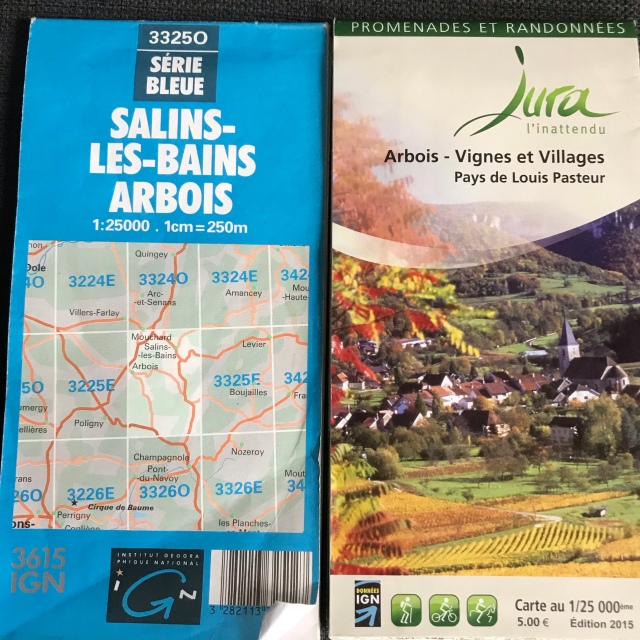
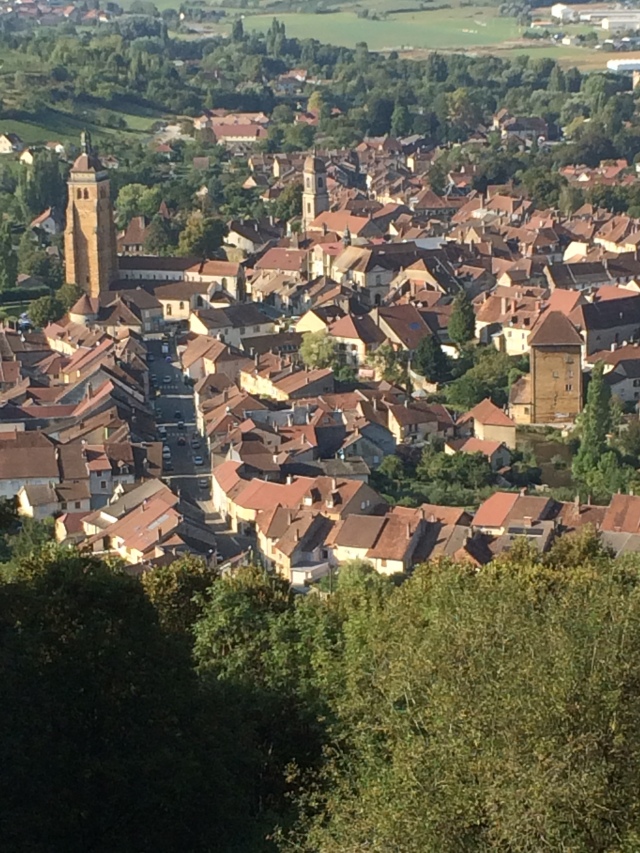















Lovely photos!
LikeLiked by 1 person
Marvelous! I’ve never had the pleasure of visiting the Jura, but it is now firmly on my list. Thank you, David.
LikeLiked by 1 person
Sat here in Burgundy reading this article made me realise we should’ve slotted in a trip to Jura. Taking K to Hirsinger earns plenty of brownie points.
If Covid-19 allows a return trip in September, I shall head to Poligny and a maiden visit to Epicurea.
LikeLiked by 1 person
Hi Mark, shame you have to come back so soon. As you probably know, our Jura passion began from a day trip when we used to stay in La Rochepôt or Meursault once a year, but you are close enough to explore Arbois and Poligny quite easily. Hirsinger is acknowledged to be up with the top Parisian patisseries, though it ain’t cheap.
LikeLike
Some useful info from Ben in Berlin, recently returned from Arbois who says:
1. La Balance seems permanently closed.
2. Claquets taken over by employee, remains same.
3. Epicurea’s Arbois branch greatly expanded wine selection.
5. Bistronome (Place Faramand) is now very good.
6. Stéphane Planche is now doing some negoce wines.
LikeLike
Lovely article and photos, thank you very much. That little town Square is indeed quite magical. And regarding “5. Bistronome (Place Faramand) is now very good” — that was our experience in September of last year as well. — Jake
LikeLiked by 1 person
Pingback: Grand Est, petit tour: The Jura | amarchinthevines